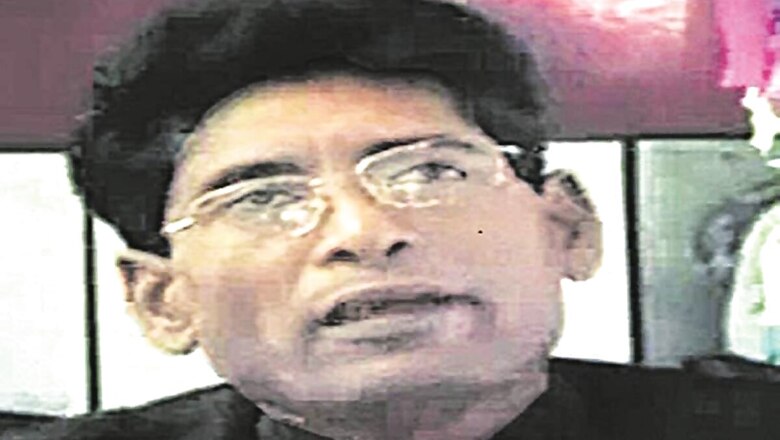
views
If you mean to ask how big a catch he is for us, Ganapathy was for the better part of the last one decade, the most wanted man in India. He had more bounty on his head than Dawood Ibrahim – this is how an officer from Chhattisgarh who has been tracking the movement of former secretary general of CPI (Maoist) Muppala Lakshmana Rao, better known as Ganapathy, described the importance of his likely surrender before Telangana police in the next few days.
The officer, who did not wish to be named, said that Ganapathy, when he was the top Maoist leader, carried a combined reward – announced by several states like Maharashtra, Chhattisgarh, Jharkhand, Odisha, Bihar, and by central agencies like NIA – of over Rs 2.5 crore. As the secretary general, he is said to have been protected by a dedicated company, number 7, of 70 armed guerrillas in a three-layer security at all times, and lorded over a private army of informants and couriers.
Who is Ganapathy
The 74-year-old is said to have a wiry frame, medium height with patches of brown in his hair that he likes to dye black every once in a while. He carried out his first big attack in 1995 by blowing up a police van carrying a DSP and 25 other policemen. All of them died in the attack.
In 2006 he brutally murdered 35 tribals in Bastar’s Errabore area, along with his associates, to counter the Salwa Judum campaign. The same year he killed 22 policemen in Upalmeta camp and blew up a van carrying 14 Naga soldiers. In 2008 he attacked CISF’s Hiroli Mines camp killing eight soldiers.
Born in Telangana’s Karimnagar district, he was a teacher by profession, and a believer in mass mobilisation movements. He was the person who established contact with insurgents groups in the North East, with LTTE in Sri Lanka and with insurgent groups in other countries like Philippines, which helped him get logistical support and weaponry.
He had a fallout with his deputy, who was the former chief of Central Military Commission (CMC), over employment of military force. Ganapathy’s stress was on political mobilisation while Basavaraju wanted the group to become more aggressive. Ultimately Basavaraju prevailed and Ganapathy was forced to quit the group.
The significance of his surrender
Interestingly, Ganapathy’s surrender coincides with the 16-year anniversary of the formation the insurgent group, which he headed since its conception in September 2004 till he was succeeded in 2018 by Basavaraj, and which former Prime Minister Manmohan Singh called the “single biggest internal security challenge ever faced by our country”.
Several high-ranking officers believe that the surrender of Ganapathy, who directly supervised some of the deadliest strikes ever carried out in India – such as the 2010 Tadmetla attack in which 76 CRPF personnel were killed and the 2013 Jhiram Ghati massacre in which 31 people died, including Congress leaders like the then Chhattisgarh Congress President Nand Kumar Patel, his son, and controversial tribal leader Mahendra Karma – will benefit the state in more ways than one.
First, it will demoralise the CPI(Maoist) cadre, which has already been withering by the drives carried out against them by security agencies, by surrenders of some high-ranking Maoists and by the non-availability of fresh recruits. Secondly, it will help security agencies get better insights not just into the modus operandi and financial resources of the Maoists but also into their future course of actions.
“His surrender will prove right many of our beliefs. Such as the Maoists are scared of being hunted down by us, that even their top boss is ready to surrender to us and that there is a rift in the party. In a way Ganapathy’s surrender is a repeat story. He was forced to quit from his group just as he had forced the ouster of senior Maoist leader Jampanna who got fed up and surrendered with his wife in Telangana,” the officer quoted above added.
That the Maoists have been rattled by the news of Ganapathy’s surrender was clear from a hastily written press release issued by them on Thursday evening. The statement claimed that, while it was true that Ganapathy had quit the party two years ago due to his ill health, the news of Ganapathy’s surrender was “a malicious propaganda” and an attempt to “defame” the group.
On the question of his ill health, which many are citing as the main reason for his surrender, the same officer expressed doubts. “The position at which he’s in, Maoists can easily get a doctor inside the jungles to his hideout to treat him. They have enough resources to create an ICU wherever they want. He’s not that unhealthy as per our last intel inputs. This theory about him bartering himself for top quality healthcare facilities doesn’t cut ice,” he said.
At the same time, though, many senior police officers are more than satisfied with the surrender of Ganapathy.
“He has been actively trying to spread the roots of Maoists in Bastar region for the past 25 years. His surrender will surely have a demoralising effect on the entire group. He will also help us investigate cases like the deadly Tadmetla attack,” said Inspector General of Police (Bastar Range) P Sundar Raj.
Another officer who has been fighting the Maoists from the frontlines, Dantewada SP Abhishek Pallava, told News18 that “Ganapathy’s surrender will surely lead to big disclosures given that his wife Sujata is still a member of the Dandakaranya special Zone committee. His surrender can lead to other senior Maoists to also think of dropping their arms and surrendering before us.”




















Comments
0 comment